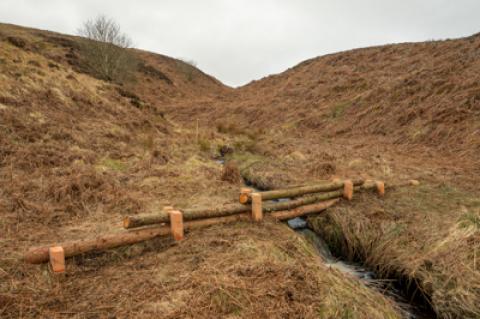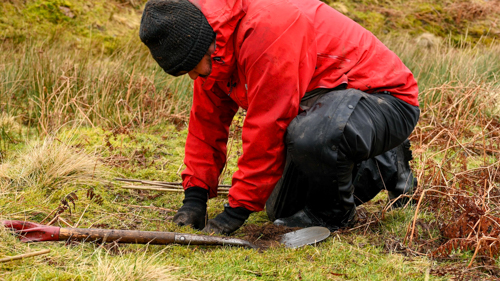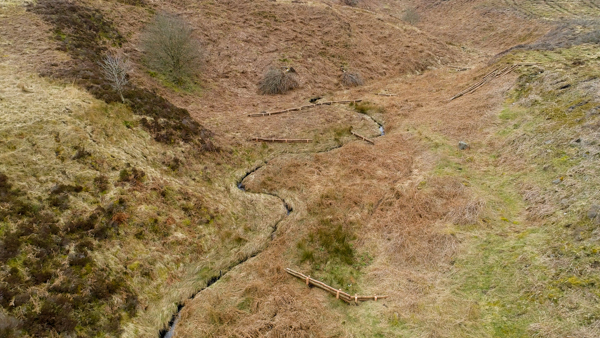
In March 2023, wooden leaky barriers were constructed over the Cairn burn and floodplain and new riparian woodland was planted, with instrumentation set up to measure impacts on water flows and chemistry.
These features are designed to moderate water flows during periods of high rainfall, retaining more water in this upper catchment area and thus reducing flooding downstream.
This work is paired with the adjacent Birnie Burn which runs through open moorland with no trees or leaky barriers - the Birnie Burn water has been monitored for several decades alreayd as part of the UK Environmental Change Network of sites.
Our experimental work and monnitoring is producing new and useful knowledge, as well as an informative demonstration site for visitors.
Background and approach:

Flooding often originates in uplands, where rainfall in a catchment is heaviest; under predicted climate change, flooding is likely to become more and more acute. The uplands are therefore key areas for tackling flooding. Natural Flood Management (NFM) can complement traditional engineering approaches and can potentially offer many benefits in terms of cost, reduced visual impact, water quality and habitat creation.
NFM works with natural features in landscapes to slow and store floodwater. One approach is using wood to partially block streams, mimicking natural wood accumulations. These ‘leaky barriers’ act to spread out the water across the flood plain during periods of high water flow, encouraging local water retention and slowing the amount of water flowing downstream. Subsequent to the high rainfall event, the water then is released more gradually from the system.
There is uncertainty about how effective NFM, using features like leaky barriers, is in the uplands. This motivated the design, placement, and monitoring of the 7 wooden leaky barriers that were set up on the Cairn Burn, at Glensaugh.

Alongside the leaky barriers, a variety of native tree species were planted along the stream margins and valley sides, to create riparian woodland which will improve floodplain roughness to further slow the flow. When mature, they will also provide woody material falling into streams acting also to slow water flows.in the same way as the leaky barriers.
We will use regular water level measurements to assess the leaky barriers. We are also monitoring changes in the floodplain and channel topography using drones and ground surveys as this helps to understand how leaky barriers can manage sediment and affect their performance for tackling flooding.
This research is supported by the Rural and Environment Science and Analytical Services Division of the Scottish Government through the ‘Achieving Multi-Purpose Nature-Based Solutions’ project 2022-2027.
Key Outputs
You can watch a video showing the construction of the leaky barriers here
A leaflet giving further information on Natural Flood Management research at Glensaugh is available here
Contact
- Mark Wilkinson: email Hydrological analysis, Project lead for ‘Achieving Multi-Purpose Nature-Based Solutions’
- Stephen Addy: email Topographical surveys, geomorphology, hydrological analysis and modelling

- Marc Stutter: email Hydrology and water quality aspects
- Paul Quinn: email Hydrological analysis and modelling
